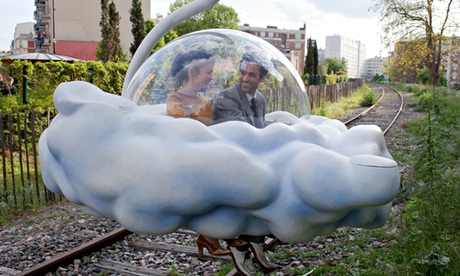
Michel Gondry is the master of stowaway genius: the killer concept smuggled past our eyes in raggedy clothing, so that its brilliance is all the more unexpected. Though his ideas are pointed and precise, their aesthetic is anything but. The work of the 51-year-old French writer-director – from the late 1980s music promos he made for his band, Oui Oui, to his most recent film, Mood Indigo, which stars Audrey Tautou and Romain Duris – has a DIY feel. He makes meticulous production design look like simple resourcefulness, using the facade of spontaneity to distract from the military precision of his art.
A typical Gondry sequence might show someone strolling through a humdrum landscape, only for oddball, surrealist miracles to casually materialise around them. Kylie Minogue running errands in the video for Come Into My World is a perfect example: she's gradually accompanied by multiple versions of herself and multiple versions of the people she passes, on an otherwise unexceptional stroll. In Michel Gondry's world, this is same-old, same-old.
Gondry's sticky back plastic Blue Peter sensibility turns cuckoo ideas into tactile reality. Each prop resembles a found object – literally so in the case of his Lego-brick animation for the White Stripes' Fell in Love With a Girl. In Eternal Sunshine of the Spotless Mind, the futuristic headgear used to purge Jim Carrey's brain of unwanted memories of his love, Clementine (Kate Winslet), resembles nothing more sophisticated than a salon hairdryer. In The Science of Sleep, the 1980s electronic game Simon with headphones attached becomes a time-travel machine, whisking users a single second into the future. Other parts of that movie are set in a corrugated-cardboard studio, from which the hero, played by Gael García Bernal, presents a television show (Stéphane TV) in his dreams. That studio made a return of sorts in Gondry's recent video for Metronomy's Love Letters, which uses nothing more complex than painted sets to take viewers from a recording studio to a deer-filled forest in a single-take treat.
Randomly sample Gondry's work and you'll find idiosyncratic design in abundance: the giant bugs and rampaging toy animals of his video for Björk's Human Behaviour; the windows within windows, beds within beds and the absurdly enlarged faces in the Chemical Brothers' video Let Forever Be; the papier-mache volcano and stop-motion building site from The Science of Sleep.
If I tell you that Bernal and Charlotte Gainsbourg gallop around on a giant fabric horse in The Science of Sleep, you may feel that you are about to OD on twee. But while Gondry's vision does dice with whimsy, there is also a redeeming sincerity in everything he creates. "I don't mock things, which makes me more vulnerable to mockery myself," he told me in 2010. "If you're cynical, you're protected from mockery. But I have to be nice. I don't think I have irony. A sense of humour, yes, but not irony."
That goes some way to explaining why Gondry's sole detour into the Hollywood mainstream – The Green Hornet, starring Seth Rogen as a hedonistic heir who becomes a costumed vigilante – failed to satisfy both his own fans and the fanboys who flock to superhero movies. The former found a slick, sleek polish sharply at odds with the Gondry aesthetic. The ideas were still there in abundance, but they no longer looked like the sort of thing a teenage geek could whip up in the garden shed.
It is for that reason that Be Kind Rewind, his 2008 comedy, is surely the consummate Gondry creation. This is partly because it is about someone like him – a film-making whiz who shoots no-budget versions of popular titles. Tinfoil, marshmallows and shaving foam are used in a makeshift version of Ghostbusters; an adroitly positioned pizza creates a halo of blood behind a dead man's head in Boyz 'n the Hood; giant boxing gloves (recalling the outsized hands Bernal wore in The Science of Sleep) help re-create the boxing documentary When We Were Kings. Jack Black even dons a floral dress and painted-on crow's feet – but neglects to ditch his desert boots – to play Jessica Tandy's part in Driving Miss Daisy. It's hard to suppress the feeling that we are watching a behind-the-scenes documentary of a typical Michel Gondry film.
Be Kind Rewind spawned the Be Kind Rewind Protocol, a project in which small studios were established in New York City to let the public make its own amateur movies. "It's not my vision of film," he said at the time. "It's my vision of what society could be: people being entertained without being part of the consumerist system." It's nice to know that behind the egg-box walls, charity-shop costumes and higgledy-piggledy chic of the Gondry landscape lies a progressive socio-political ethos: the considered masquerading as the casual once more.
• Mood Indigo opens 1 August.
• The DIY art of Michel Gondry – in pictures

